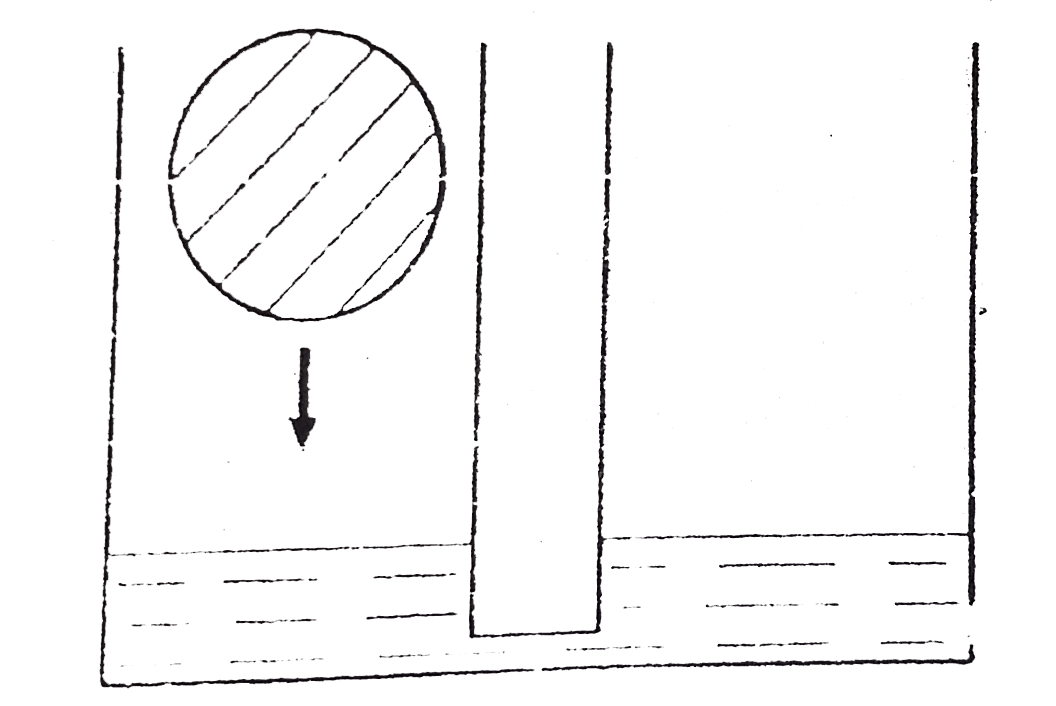What fraction of an iceberg ice beneath the surface of the sea? Density of sea water (ρ)=1.028×103kg/m3, density of ice d. =0.917×103kg/m3
To solve the problem of determining what fraction of an iceberg is submerged beneath the surface of the sea, we can use Archimedes' principle. Here’s a step-by-step solution:
Step 1: Understand the Problem
We need to find the fraction of the iceberg that is submerged in the sea. We know the densities of sea water and ice.
Step 2: Identify Given Data
- Density of sea water, ρwater=1.028×103kg/m3
- Density of ice, ρice=0.917×103kg/m3
Step 3: Apply Archimedes' Principle
According to Archimedes' principle, the weight of the fluid displaced by the submerged part of the iceberg is equal to the weight of the iceberg itself.
Mathematically, this can be expressed as:
ρwater⋅Vimmersed⋅g=ρice⋅Vice⋅g
Here, Vimmersed is the volume of the iceberg submerged in the water, and Vice is the total volume of the iceberg.
Step 4: Cancel Out Common Terms
Since g (acceleration due to gravity) is present on both sides of the equation, we can cancel it out:
ρwater⋅Vimmersed=ρice⋅Vice
Step 5: Express the Fraction of Ice Submerged
We want to find the fraction of the iceberg that is submerged, which is given by:
VimmersedVice=ρiceρwater
Step 6: Substitute the Values
Now substituting the values of the densities:
VimmersedVice=0.917×1031.028×103
Step 7: Calculate the Fraction
Now performing the calculation:
VimmersedVice=0.9171.028≈0.891
Step 8: Convert to Percentage
To express this as a percentage:
Percentage submerged=0.891×100≈89.1%
Final Answer
Approximately 89.1% of the iceberg is submerged beneath the surface of the sea.
---
We need to find the fraction of the iceberg that is submerged in the sea. We know the densities of sea water and ice.
- Density of sea water, ρwater=1.028×103kg/m3
- Density of ice, ρice=0.917×103kg/m3
According to Archimedes' principle, the weight of the fluid displaced by the submerged part of the iceberg is equal to the weight of the iceberg itself.
ρwater⋅Vimmersed⋅g=ρice⋅Vice⋅g
Here, Vimmersed is the volume of the iceberg submerged in the water, and Vice is the total volume of the iceberg.
Since g (acceleration due to gravity) is present on both sides of the equation, we can cancel it out:
ρwater⋅Vimmersed=ρice⋅Vice
We want to find the fraction of the iceberg that is submerged, which is given by:
VimmersedVice=ρiceρwater
Now substituting the values of the densities:
VimmersedVice=0.917×1031.028×103
Now performing the calculation:
VimmersedVice=0.9171.028≈0.891
To express this as a percentage:
Percentage submerged=0.891×100≈89.1%
Approximately 89.1% of the iceberg is submerged beneath the surface of the sea.
Topper's Solved these Questions
- FLUID MECHANICSBook:CENGAGE PHYSICS ENGLISHChapter:FLUID MECHANICSExercise:Solved Examples
Explore 7 Videos
- FLUID MECHANICSBook:CENGAGE PHYSICS ENGLISHChapter:FLUID MECHANICSExercise:Exercise 4.1
Explore 11 Videos
- DIMENSIONS & MEASUREMENTBook:CENGAGE PHYSICS ENGLISHChapter:DIMENSIONS & MEASUREMENTExercise:Integer
Explore 2 Videos
- GRAVITATIONBook:CENGAGE PHYSICS ENGLISHChapter:GRAVITATIONExercise:INTEGER_TYPE
Explore 1 Video
Similar Questions
An iceberg floats on fresh water with a part of it outside the water surface. Calculate the fraction of the volume of the iceberg which is below the water surface.
Given : density of ice =917kgm−3, density of fresh water =1000kgm−3
View SolutionA piece of alloy of gold and silver weighs 2 kg in air and 1.86 kg in water. What is the mass of silver? Density of gold is 19.3×103kgm−3 . Density of silver is 10.5×103kgm−3
View SolutionWater rises up in a glass capillary upto a heigh 10 cm, while mercury falls down by 3.5 cm in the same capillary. If the angles of contact for water-glass and mercury-glass are taken as 0∘ and 135∘ respectively, compare the surface tensions of water and mercury. [Given density of water = 103 kg m−3, density of mercury = 13.6 ×103 kg m−3]
View SolutionIf the density of ice is 0.9gcm−3, what portion of an iceberg will remain below the surface of water in a sea? (Density of sea water =1.1gcm−3)
View SolutionAn ice berg floats on fresh water with a part of it outside the water surface. Calculate the fraction of the volume of the ice berg which is below the water surface. (Density of ice = 917kgm−3, Density of water = 1000kgm−3 )
View SolutionA tank contains water and mercury as shown in figure. An iron cube of edge d=6 cm is in equilibrium as shown. (density of iron =7.8×103kg/m3, density of mercury =13.6×103kg/m3, density of water =103kgm3)(Neglect the atmospheric pressure)

Time period of small oscillations of block is
View SolutionTwo metal spheres are falling through a liquid of density 2×103kg/m3 with the same uniform speed. The material density of sphere 1 and sphere 2 are 8×103kg/m3 and 11×103kg/m3 respectively. The ratio of their radii is :-
View SolutionA metallic sphere of radius 1.0×10−3m and density 1.0×104kg/m3 enters a tank of water, after a free fall through a distance of h in the earth's gravitational field. If its velocity remains unchanged after entering water, determine the value of h. Given: coefficient of viscosity of water =1.0×10−3Ns/m2,g=10ms−12 and density of water =1.0×103kg/m3.
View SolutionIn two identical communicating vessel we poured water (see picture). In one of them we put an ice ball of volume V=100cm3 which gets exactly half immersed in the water. The density of water ρw=1000kg/m3 the density of ice ρi=900kg/m3

Select the correct statement (s). Soon after placing the ice ball in left vessel.
View SolutionWhat is the terminal velocity of a copper ball of radius 2.0 mm, which falls through an oil tank? Given that density of oil = 1.5×103 kg m−3, density of copper =8.9×103kgm−3 and viscosity of oil is 0.99 kg m−1s−1.
View Solution